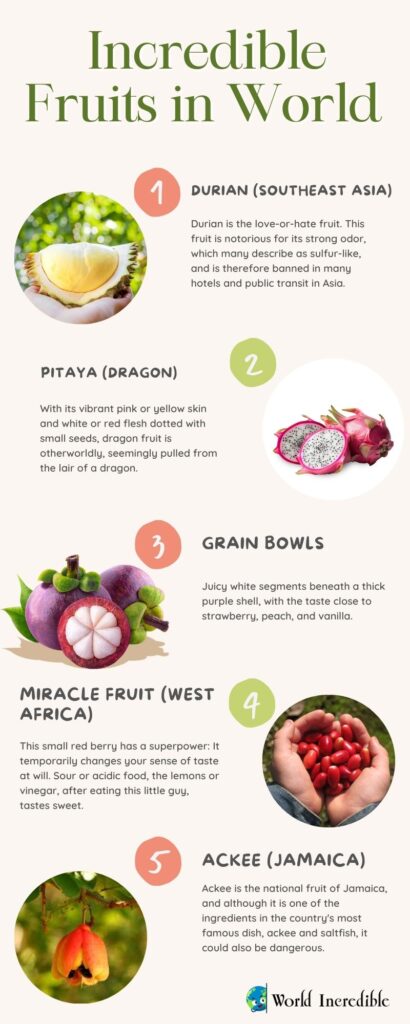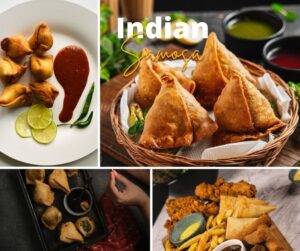Nature is full of wonders, and among her fascinating creations are the fruits. Vivid, wacky-looking, strongly nutritious, and sometimes just plain weird, these fruits from all over the world defy our expectations and rejoice our senses. From the odoriferous durian of Southeast Asia to West Africa’s miracle berry, which alters sweetness, here are 10 truly amazing fruits you want to put on your travel and tasting bucket list.
List of 10 Incredible Fruits in World
| Fruit | Region | Key Features | Why It’s Incredible |
|---|---|---|---|
| Durian | Southeast Asia | Spiky shell, strong odor, creamy yellow flesh | Known as the “King of Fruits”; rich in healthy fats and energy; flavor is polarizing. |
| Dragon Fruit | Central America, Asia | Bright pink/yellow skin, white/red flesh with seeds | Vibrant, mildly sweet; high in Vitamin C and antioxidants. |
| Mangosteen | Southeast Asia | Thick purple rind, white juicy segments | Called the “Queen of Fruits”; sweet, tangy, and packed with antioxidants. |
| Miracle Fruit | West Africa | Small red berry | Contains miraculin, which makes sour foods taste sweet. |
| Ackee | Jamaica | Red pod opens to reveal yellow, brain-like flesh | National fruit of Jamaica; edible only when ripe; used in traditional cuisine. |
| Buddha’s Hand | China, India | Yellow, finger-like citrus with no pulp | Used for zest and fragrance; visually unique and aromatic. |
| Rambutan | Southeast Asia | Hairy red/yellow skin, translucent white flesh | Similar to lychee; juicy, sweet, and rich in iron and Vitamin C. |
| Jabuticaba | Brazil | Grows on tree trunk; looks like purple grapes | Sweet, tart; used in jellies and wines; anti-inflammatory properties. |
| Salak (Snake Fruit) | Indonesia | Reddish-brown, scaly skin; white, crunchy flesh | Tastes like apple and pineapple; high in antioxidants. |
| Kiwano (Horned Melon) | Central/Southern Africa | Spiky orange skin, green jelly-like flesh | Tastes like cucumber, banana, and lime; very hydrating and high in Vitamin C. |
10 Incredible Fruits from Every Corner of the Planet
1. Durian (Southeast Asia)
Common name: King of Fruits
Why it’s amazing:
Durian is the love-or-hate fruit. This fruit is notorious for its strong odor, which many describe as sulfur-like, and is therefore banned in many hotels and public transit in Asia.
But beyond this odor lies a custardy flesh that many describe as tasting of almonds, caramel, and — yes — onion. It is loaded with good fats, fibers, and vitamins, making it as energizing as unforgettable.
2. Pitaya (dragon)
Originally from: Central America, now widely cultivated in Asia
Why it’s so awesome:
With its vibrant pink or yellow skin and white or red flesh dotted with small seeds, dragon fruit is otherworldly, seemingly pulled from the lair of a dragon. Mildly sweet, its flavor is often cited as something between that of kiwi and pear. Dragon fruit is rich in antioxidants, fiber, and vitamin C.
3. Mangosteen (Southeast Asia)-
Also known as- The Queen of Fruits.
Why it’s wonderful: Juicy white segments beneath a thick purple shell, with the taste close to strawberry, peach, and vanilla. Mangosteen is a delicious fruit not only because of its heavenly flavor but even more highly reputed due to its anti-inflammatory and antioxidant properties.
4. Miracle Fruit (West Africa)-
Why it’s great: This small red berry has a superpower: It temporarily changes your sense of taste at will. Sour or acidic food, the lemons or vinegar, after eating this little guy, tastes sweet. The berry itself is mild, but the experience is unforgettable — like turning your mouth into a flavor-bending lab!
5. Ackee (Jamaica) –
Why it’s wonderful: Ackee is the national fruit of Jamaica, and although it is one of the ingredients in the country’s most famous dish, ackee and saltfish, it could also be dangerous. Unsafely prepared or unripe ackee can be poisonous when eaten. Cooked correctly, however, the yellow flesh has a firm, rich, buttery flavor, which goes beautifully with savory ingredients.
READ ALSO: Top 10 Summer Season Fruits We Love To Eat
6. Buddha’s Hand Fruit (China)
Incredible Factor:
This fruit looks like a bunch of fingers from a yellow hand extending from a base; hence, the name. Unlike common fruits, it has no pulp or juice. It is instead valued for intensely fragrant zest, which is used in perfume, liqueurs, or simply as a natural air freshener. A true case of fruit as art.
7. Rambutan (Southeast Asia)
Incredible Factor:
Rambutan may be described as lychee’s wild-haired cousin. This fruit’s exterior is spiky and hairy conceals a juicy, sweet, and slightly floral translucent flesh that is considered a treasure. It also excels at offering vitamin C, iron, and antioxidant benefits to nourish you in the most entertaining way.
8. Jabuticaba (Brazil)
Incredible Factor:
The Jabuticaba is the offspring that grow on the trunk of the tree itself, resembling black grapes stuck to bark. It has a sour skin encasing a sweet jelly-like inside.
The fruits have anti-inflammatory properties used to support digestion and immunity and are popular in making wines, liqueurs, and jelly.
9. Salak (Snake Fruit, Indonesia)
Incredible Factor:
Salak arises from its scaly reddish-brown skin similar to snake scales.
The inside gives a crunchy bite and has a flavor that combines apple with banana and some hints of citrusy tang. They contain potassium and high content in antioxidants, which is why they’re one of the best local snacks, a superfruit.
10. Kiwano – African Horned Cucumber
Where it comes from: Central and Southern Africa
Why it is unbelievable:
This protruding fruit, which has a bright orange peel and jelly-like flesh of lime green, is like something from an alien planet. The flavor? Its flavor combines with cucumber, banana, and lemon. Kiwano is hydrating and a great source of Vitamin C, serving either raw or as a tropical addition to drinks and smoothies.
For sure, these fruits are more than exotic snacks; they stand as stories of biodiversity, culture, and culinary creativity from across the world. Wherever your travels may take you, whether to an Asian market down the street or simply to put a bit of fun into your fruit bowl, these wonderful fruits are sure to shock and enchant.
READ BLOG: Top 50 Healthy Summer Season Fruits to Enjoy
Frequently Asked Questions (FAQs)
1. Where can I find these fruits?
Fruits like dragon fruit, mangosteen, and rambutan are commonly found in Asian or international markets, particularly in larger cities. Others require specialty stores and online suppliers, such as miracle fruit or jabuticaba. The best way to try these fruits is to visit their native habitats!
2. Are these fruits edible?
Most are edible if properly prepared, while some become toxic if eaten unripe or uncooked, ackee being one of those. Do proper research, and seek advice from locals when consuming unfamiliar fruits, particularly in their natural habitat.
3. Which fruit is the best for beginners to try?
Dragon fruit and rambutan are really a good start. These fruits are widely available, easy to prepare, and their mild and forgiving flavor is generally agreeable to most palates.
4. Can I grow these fruits at home?
Some fruits can be grown at home, such as dragon fruit and jabuticaba, if you live in a warm tropical climate, or have a greenhouse. Others, like durian or mangosteen, require specific conditions and are more difficult to grow.
5. What is the most unique fruit on this list?
Miracle fruit is one exceptional mention due to its unique effect of changing taste perception, sweetening sour foods. Buddha’s Hand is also in the running for that recognition due to its eccentric appearance and having no edible flesh at all.
READ ALSO: Acai Berry Smoothie Recipes for Women with PCOD
Have You Tasted Any of These?
Which one captures your imagination most? Leave a comment below — or better yet, attach a photo if you had the courage to try one!













